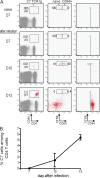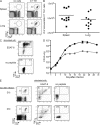Delayed protection by ESAT-6-specific effector CD4+ T cells after airborne M. tuberculosis infection
- PMID: 18779346
- PMCID: PMC2556792
- DOI: 10.1084/jem.20080353
Delayed protection by ESAT-6-specific effector CD4+ T cells after airborne M. tuberculosis infection
Abstract
Mycobacterium tuberculosis infection induces complex CD4 T cell responses that include T helper type 1 (Th1) cells and regulatory T cells. Although Th1 cells control infection, they are unable to fully eliminate M. tuberculosis, suggesting that Th1-mediated immunity is restrained from its full sterilizing potential. Investigation into T cell-mediated defense is hindered by difficulties in expanding M. tuberculosis-specific T cells. To circumvent this problem, we cloned CD4(+) T cells from M. tuberculosis-infected B6 mice and generated transgenic mice expressing a T cell receptor specific for the immunodominant antigen early secreted antigenic target 6 (ESAT-6). Adoptively transferred naive ESAT-6-specific CD4(+) T cells are activated in pulmonary lymph nodes between 7 and 10 d after aerosol infection and undergo robust expansion before trafficking to the lung. Adoptive transfer of activated ESAT-6-specific Th1 cells into naive recipients before aerosol M. tuberculosis infection dramatically enhances resistance, resulting in 100-fold fewer bacteria in infected lungs. However, despite large numbers of Th1 cells in the lungs of mice at the time of M. tuberculosis challenge, protection was not manifested until after 7 d following infection. Our results demonstrate that pathogen-specific Th1 cells can provide protection against inhaled M. tuberculosis, but only after the first week of infection.
Figures





Similar articles
-
ESAT-6-specific CD4 T cell responses to aerosol Mycobacterium tuberculosis infection are initiated in the mediastinal lymph nodes.Proc Natl Acad Sci U S A. 2008 Aug 5;105(31):10961-6. doi: 10.1073/pnas.0801496105. Epub 2008 Jul 30. Proc Natl Acad Sci U S A. 2008. PMID: 18667699 Free PMC article.
-
Mycobacterium tuberculosis Rv3615c is a highly immunodominant antigen and specifically induces potent Th1-type immune responses in tuberculosis pleurisy.Clin Sci (Lond). 2017 Jul 5;131(15):1859-1876. doi: 10.1042/CS20170205. Print 2017 Aug 1. Clin Sci (Lond). 2017. PMID: 28588103
-
Quality and vaccine efficacy of CD4+ T cell responses directed to dominant and subdominant epitopes in ESAT-6 from Mycobacterium tuberculosis.J Immunol. 2009 Aug 15;183(4):2659-68. doi: 10.4049/jimmunol.0900947. Epub 2009 Jul 20. J Immunol. 2009. PMID: 19620314
-
In Vivo Antigen Expression Regulates CD4 T Cell Differentiation and Vaccine Efficacy against Mycobacterium tuberculosis Infection.mBio. 2021 Apr 20;12(2):e00226-21. doi: 10.1128/mBio.00226-21. mBio. 2021. PMID: 33879592 Free PMC article.
-
Mycobacterium tuberculosis-specific CD8+ T cells and their role in immunity.Crit Rev Immunol. 2006;26(4):317-52. doi: 10.1615/critrevimmunol.v26.i4.30. Crit Rev Immunol. 2006. PMID: 17073557 Free PMC article. Review.
Cited by
-
TGFβ restricts expansion, survival, and function of T cells within the tuberculous granuloma.Cell Host Microbe. 2021 Apr 14;29(4):594-606.e6. doi: 10.1016/j.chom.2021.02.005. Epub 2021 Mar 11. Cell Host Microbe. 2021. PMID: 33711270 Free PMC article.
-
Immune subversion by Mycobacterium tuberculosis through CCR5 mediated signaling: involvement of IL-10.PLoS One. 2014 Apr 2;9(4):e92477. doi: 10.1371/journal.pone.0092477. eCollection 2014. PLoS One. 2014. PMID: 24695099 Free PMC article.
-
Monitoring CD27 expression to evaluate Mycobacterium tuberculosis activity in HIV-1 infected individuals in vivo.PLoS One. 2011;6(11):e27284. doi: 10.1371/journal.pone.0027284. Epub 2011 Nov 7. PLoS One. 2011. PMID: 22087280 Free PMC article.
-
Mucosal Vaccination with Cyclic Dinucleotide Adjuvants Induces Effective T Cell Homing and IL-17-Dependent Protection against Mycobacterium tuberculosis Infection.J Immunol. 2022 Jan 15;208(2):407-419. doi: 10.4049/jimmunol.2100029. Epub 2021 Dec 29. J Immunol. 2022. PMID: 34965963 Free PMC article.
-
Functional and Phenotypic Changes of Natural Killer Cells in Whole Blood during Mycobacterium tuberculosis Infection and Disease.Front Immunol. 2018 Feb 19;9:257. doi: 10.3389/fimmu.2018.00257. eCollection 2018. Front Immunol. 2018. PMID: 29520269 Free PMC article.
References
-
- Keane, J., S. Gershon, R.P. Wise, E. Mirabile-Levens, J. Kasznica, W.D. Schwieterman, J.N. Siegel, and M.M. Braun. 2001. Tuberculosis associated with infliximab, a tumor necrosis factor alpha-neutralizing agent. N. Engl. J. Med. 345:1098–1104. - PubMed
-
- van de Vosse, E., M.A. Hoeve, and T.H. Ottenhoff. 2004. Human genetics of intracellular infectious diseases: molecular and cellular immunity against mycobacteria and salmonellae. Lancet Infect. Dis. 4:739–749. - PubMed
-
- Flynn, J.L., M.M. Goldstein, J. Chan, K.J. Triebold, K. Pfeffer, C.J. Lowenstein, R. Schreiber, T.W. Mak, and B.R. Bloom. 1995. Tumor necrosis factor-alpha is required in the protective immune response against Mycobacterium tuberculosis in mice. Immunity. 2:561–572. - PubMed
Publication types
MeSH terms
Substances
Grants and funding
LinkOut - more resources
Full Text Sources
Other Literature Sources
Medical
Molecular Biology Databases
Research Materials

